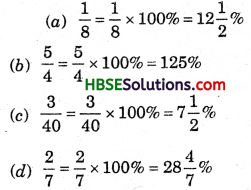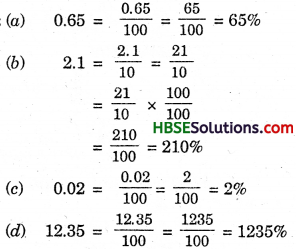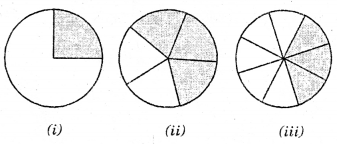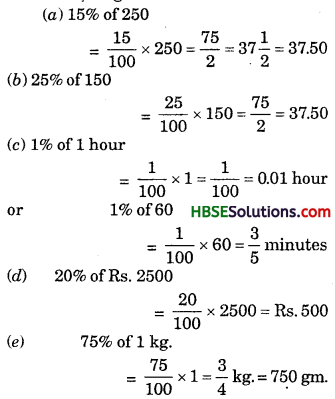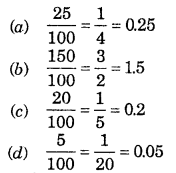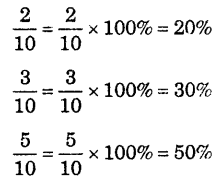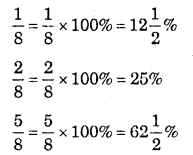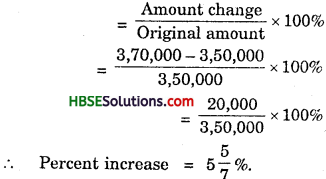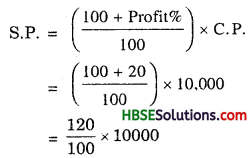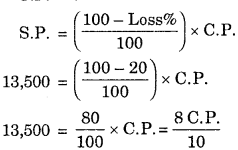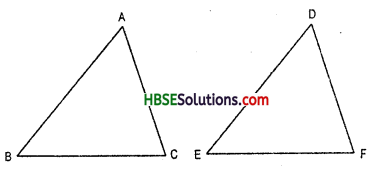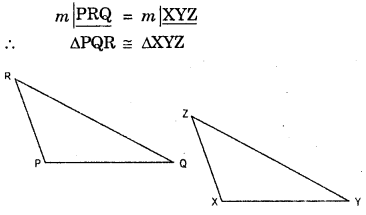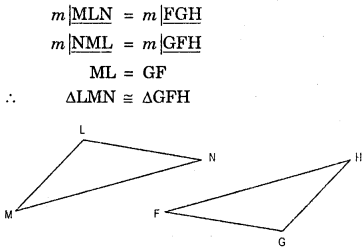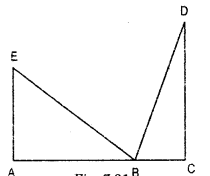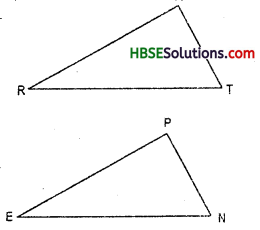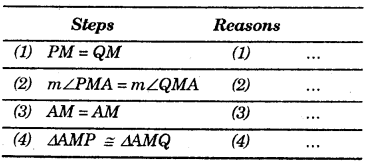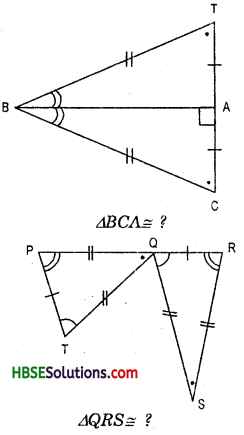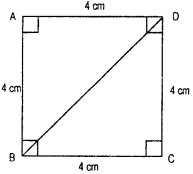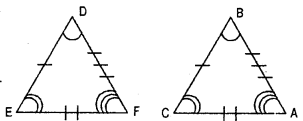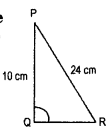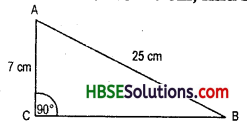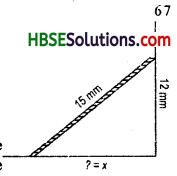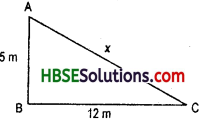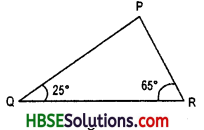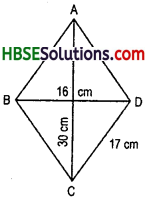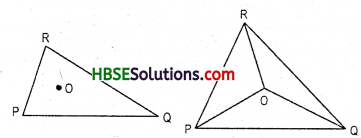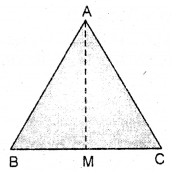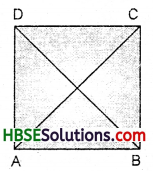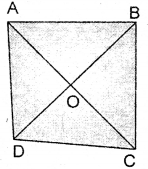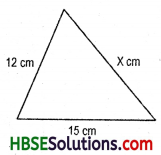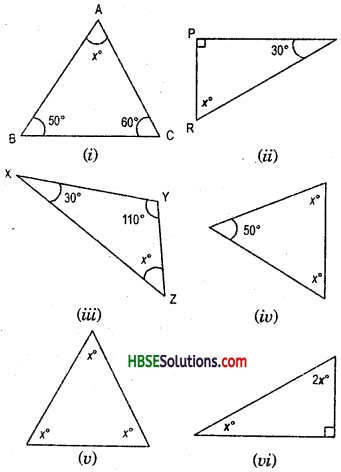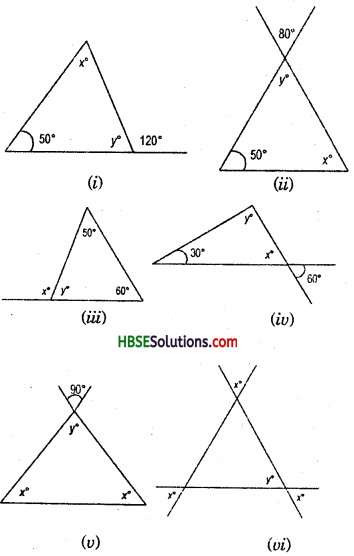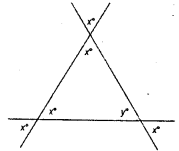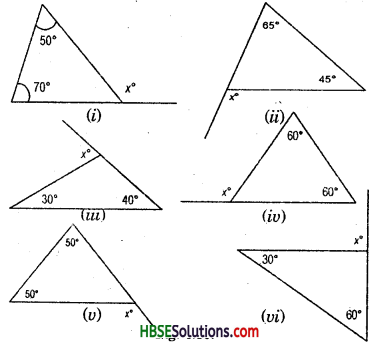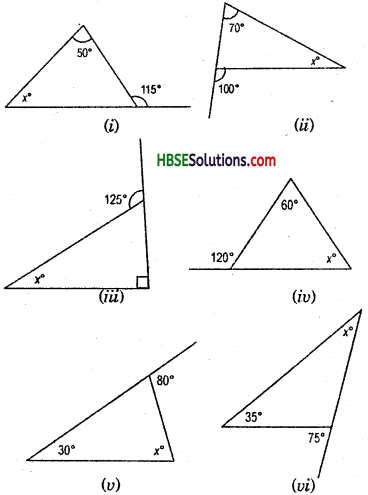Haryana State Board HBSE 7th Class Maths Solutions Chapter 6 The Triangles and Its Properties InText Questions and Answers.
Haryana Board 7th Class Maths Solutions Chapter 6 The Triangles and Its Properties InText Questions
Try These (Page No. 113-114):
Question 1.
Write the six elements (i.e. the 3 sides and the 3 angles) of AABC.
Solution:
Six elements of ΔABC are : ∠A, ∠B, ∠C, \(\overline{\mathrm{AB}}, \overline{\mathrm{BC}}\) and \(\overline{\mathrm{CA}}\).
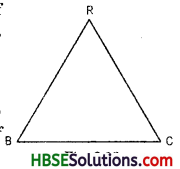

Question 2.
Write the :
(i) Side opposite to
the vertex Q of B ΔPQR.
(ii) Angle opposite to the side LM of ΔLMN
(iii) Vertex oppostie to the side RT of ΔRST.
Solution:
A triangle is simple closed curve mode of three line segments. It has three vertices, three sides and three angles.
(i) Side opposite to the vertex Q of ΔPQR is PR.
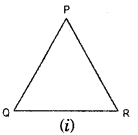
(ii) Angle opposite to side LM of ΔLMN is ∠LMN

(iii) Vertex opposite to the side RT of ΔRST is S.
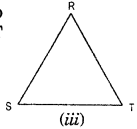
Question 3.
Look at the Fig. and classify each of the triangles according to its (a) Sides (b) Angles
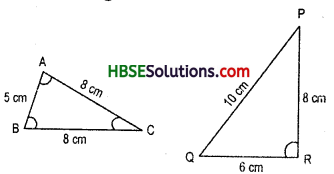
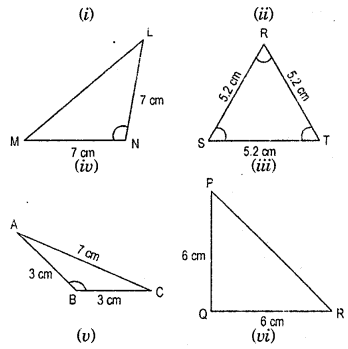
Solution:
(a) Sides : We may classify the triangles according to their sides as follows:
I. A triangle having no two sides equal is called a scalene triangle.
II. A triangle having two sides equal is called an isosceles triangle.
III. A triangle having all sides equal is called an equilateral triangle.
Hence, (ii) ΔPQR is scalene triangle.
(i) ΔABC, (iii) ΔLMN, (v) ΔABC and
(vi) ΔPQR are isosceles triangle, and;
(iv) ARST is equilateral triangle.
(b) Angles : According to angles :
I. A triangle, all of whose angles are acute, is called an acute angle triangle.
II. A triangle, one of whose angles is right angle, is called right angle triangle.
III. A triangle one of whose angles is obtuse, is called an obtuse angle triangle.
Hence, (i) ΔABC, (iv) ΔRST are acute angle triangle.
(ii) ΔPQR, (vi) ΔPQR arc right angle triangle.
(iii) ΔLMN, (v) ΔABC are obtuse angle triangle.

Think, Discuss & Write (Page No. 114):
Question 1.
How many medians can a triangle have? .
Solution:
The line segment, joining the mid point to its opposite vertex are called a median of the triangle. In a triangle has three vertex. Hence in a triangle has three median. (Fig. 6.19)
Question 2.
Does a median lie wholly in the interior of the triangle ? (If you think that this is not true, draw a figure to show such a case).
Solution:
In a triangle ABC three median AL, BM, CN meet the point O. Hence a median lie wholly in the interior of the triangle.
Think, Discuss & Write (Page No. 115):
Question 1.
How many altitudes can a triangle have ?
Solution:
An altitude has one end point at a vertex of the triangle and the other on the line containing the opposite side. In a triangle has three vertex. So it has three altitude.
e.g. AD, BE, CF are altitude of triangle.
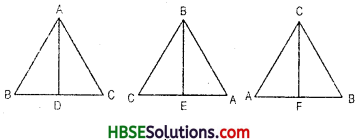
Question 2.
Draw rough sketches of altit udes from A to \(\overline{\mathrm{BC}}\) for the given triangles :
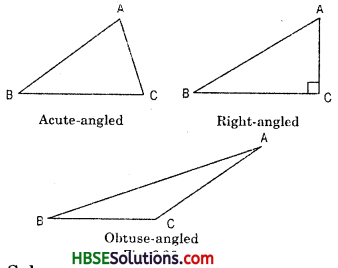
Solution:

Question 3.
Will an altitude always lie in the interior of triangle ? If you think that this need not be true, draw a rough sketch to show such a case.
Solution:
Yes.
Question 4.
Can you think of a triangle in which two altitudes of the triangle are two of its sides ?
Solution:
A triangle has three vertices, and for each vertex there is an altitude. Thus, a triangle has three altitudes. Thus, a triangle in which two altitude of the triangle and two of its sides.
Question 5.
Can the altitude and median be same for a triangle ?
(Hint: For Q. No. 4 and 5, investigate by drawing the altitudes for every type of triangle.)
Solution:
No, the altitude and median arc not same for a tringle.

Think, Discuss & Write (Page No. 118):
Question 1.
Exterior angles can be formed for a triangle in many ways. Three of them are shown here (fig)

There are three more ways of getting exterior angles. Try to produce those rough sketches.
Solution:
We know that an exterior angle of a triangle is equal to the sum of its interior opposite angles.
i.e. ∠1 + ∠2 = ∠3
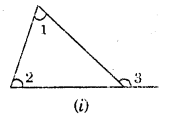
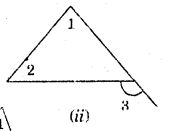
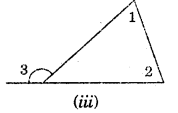
Question 2.
Are the exterior angles formed at each vertex of a triangle equal?
Solution:
(See Fig. ) ∠4 =∠5 (vertically opposite angles )

Question 3.
What can you say about the sum of an exterior angle of a triangle and its adjacent interior angle ?
Solution:
∠ACX is called an exterior angle of the ΔABC atC. (Fig. 6.28)
∠ACB is not adjacent ot ∠ACX.
∠ACB is the interior adjacent angle.
∠A and ∠B are not the interior adjacent angles. They are called the interior angles. They are called the interior opposite angles corresponding to exterior angles ∠ACX.
i.e. Sum of an exterior angles and at vertex -C vertically other angles are equal to 360°.
Think, Discuss & Write (Page No. 118):
Question 1.
What can you say about each of the interior opposite angles, when the exterior angles is
(i) a right angle? (ii) an obtuse angle ? (iii) an acute angle.
Solution:
An exterior angle of a triangle is equal to the sum of its interior oppsite singles, (i) a right angle, i.e. (ii) an obtuse angle.
Question 2.
Can the exterior angle of a triangle be a straight angle ?
Solution:
No; because a straight angle = 180°.
Try These (Page No. 118):

Question 1.
An exterior angle of a triangle is of measure 70° and one of its interior opposite angles is of measure 25°. find the measure of the other interior oppsite angle.
Solution:
Let us take m to be the number of
parmit’s marbles other interior opposite angle
= exterior angle — first interior
= oppsite angle
= 70° – 25° = 45°
Question 2.
The two interior opposite angles of an exterior angle of a triangle are 60° and 80°. Find the measure of the exterior angle.
Solution:
Exterior angles = 60° + 80° = 140°.
Question 3.
Is something wrong in this diagram (Fig.) ? Comment.
Solution:
We know that,
The sum of interior opposite angles = exterior angles
but from figure,
50 ≠ 50°
Hence this diagram ‘ is wrong.
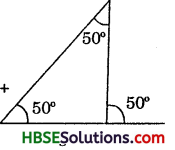
Try These (Page No. 122):
Question 1.
Two angles of a triangle are 30° and 80°.
Find the third angle.
Solution:
By angle – sum property of a triangle
30° + 80° + x° = 180°
110° +x° =180°
∴ x° = 180° – 110° = 70°
∴ third angle = x° = 70°
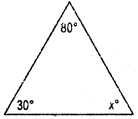
Question 2.
One of the angles of a triangle is 80° and the other two anlges are equal. Find the measure of each of the equal angles.
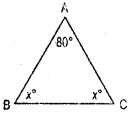
Solution:
By angle – sum property of a triangle
x° + x° + 80° = 180°
or, 2x°+ 80° = 180°
or, 2x° = 180° -80°
= 100°
= \(\frac{100^{\circ}}{2}\) = 50°
angles are 50°, 50°, 80°

Question 3.
The three angles of a triangle are in the ratio 1:2:1. Find all the angles of the triangle. Classify the triangle in two different ways.
Solution:
Let the ratio be x :2x:x By angle – sum property of a triangle

x + 2r + x = 180°
or 4x = 180°
or x = \(\frac{180^{\circ}}{4}\) = 45°
∴ angles are 45°, 90°, 45°
Thus the triangles are Right angled and isosceles triangles.
Think, Discuss & Write (Page No. 122):
Question 1.
Can you have a triangle with two right angles ?
Solution:
Since, the three angles of a triangle have a total measure of 180°.
Hence we cannot have a triangle with two right angles.
Question 2.
Can you have a triangle with two obtuse angles ?
Solution:
No, Because obtuse angle > 90°.
Question 3.
Can you have a triangle with two acute angles ?
Solution:
Yes, Because acute angle < 90°.
Question 4.
Can you have a triangle with all the three angles greater than 60° ?
Solution:
No, Because the three angles of a triangle have a total measure of 180°.
Question 5.
Can you have a triangle with all the three angles equal to 60° ?
Solution:
Yes, Because 60° + 60° + 60° = 180°.
Question 6.
Can you have a triangle with all the three angles less than 60° ?
Solution:
No, Because the three angles of a triangle have a total measure of 180°.
Try These (Page No. 123- 124):
Question 1.
Find angles x in each Fig.
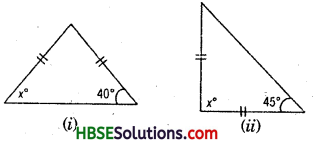
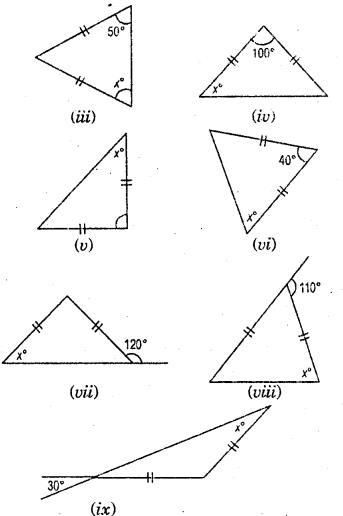
Solution:
In an isosceles triangle
(a) two sides have same length
(b) base angles opposite to the equal sides are equal.
Hence, (i) x° = 40°
(ii) x° + 45° + 45° = 180°
or, x° + 90° = 180°
.’. x° = 180°-90° = 90°
(iii) x° = 50°
(iv) x°+x° + 100° = 180°
2x° = 180°-100° = 80°
x° = \(\frac{80^{\circ}}{2}\) = 40°
(v) x° + x° + 90° = 180°
or, 2x° = 180°-90° = 90°
x° = \(\frac{90^{\circ}}{2}\) = 45°

(vi) x° + x° + 40° = 180°
or, 2x° = 180°-40° = 140°
x° = \(\frac{140^{\circ}}{2}\) = 70°
(vii) x° + 120° = 180° = Linear pair
or, x° = 180°-120°
.. x° = 60°. (Fig. )
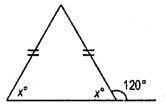
(viii) y° + 110° = Linear pair = 180°
or, y° =180° —110°
y° =70°
Now, x° + x° + y° = 180°
or, 2x° + 70° =180°
2x° =180°-70° = 110°
.’. x = \(\frac{110}{2}\) = 55°
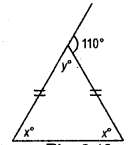
(ix) 30° =30°
= vertically opposite angle
x° =30°,
Because base angles opposite to the equal sides are equal. (Fig.)
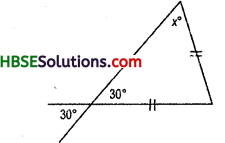
Question 2.
Find angles x andy each Fig.
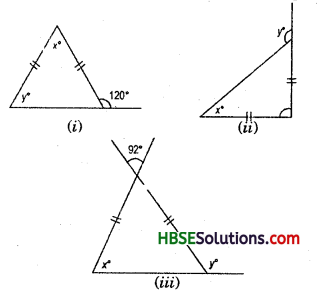
In isosceles triangle base angled are equal. Hence y° = z°
Solution:
(i) z° + 120° = Linear pair = 180°
∴ z° =180° -120°
∴ z° = 60°
or, x°+y° + 2° = 180° (.-. y° = z°)
x° + 60° + 60° = 180°
or, x° = 180°-120° = 60°
∴ x° = 60°,
y° = 60°
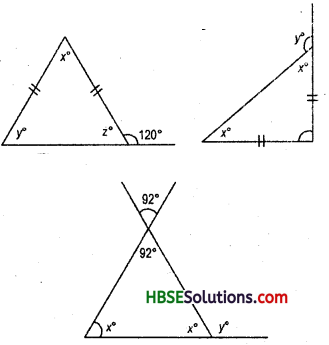
(ii) x° + x° + 90° = 180°
or, 2x° = 180° – 90° = 90°
∴ x° = \(\frac{90}{2}\) = 45°
or, x° + y° = 180° = linear pair
45° +y° = 180°
∴ y° = 180°-45° = 135°
∴ x° = 45°,
y° = 135°
(iii) 92°+ 92° = vertically opposite angle
x° + x° + 92° = 180°
or, 2x° = 180° – 92° = 88°
∴ x = \(\frac{88}{2}\) = 44°
or, x° + y° = linear pair = 180°
44° + y = 180°
y = 180°-44° = 136°
∴ x° = 44°,
y° = 136°.

Think, Discuss & Write (Page No. 127):
Question 1.
Is the sum of any two angles of a triangle always greater than the third angle ?
Solution:
In a triangle, the sum of any two sides of a triangle is always greater than the third side.
Think, Discuss & Write (Page No. 130):
Question 1.
Find the unknown length x in the following figures :
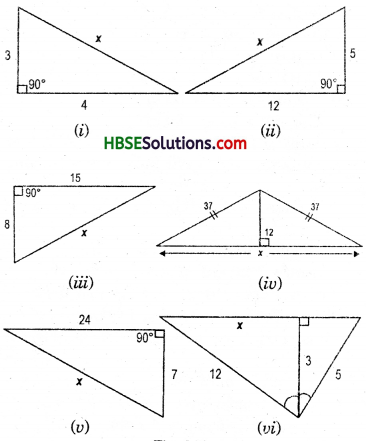
Solution:
By Pythagoras property,
i.e. h2 = p2 + b2
Hence, (i) x2 = 32 + 42
x2 = 9 + 16
x = \(\sqrt{25}\)
∴ x = 5
(ii) x2 = (12)2 + 52
∴ x = \(\sqrt{169}\) = 13
∴ x = 13
(iii) x2 = 82 + 152 = 64 + 225 = 289
∴ x = \(\sqrt{289}\) = 17
∴ x = 17
(iv) x2 = 72 + 242 = 49 + 576 = 625
∴ x = \(\sqrt{625}\)
∴ x = 25
(v) h2 = p2 + b2
In ΔABD, b2 = h2 – p2 = (37)2 – (12)2
= 1369-144 = 1225
b = \(\sqrt{1225}\) = 35
= 35 + 35 = 70
(vi) (12)2 = 32 + x2
144 – 9 = x2
or, 135 = x2,
∴ x = \(\sqrt{135}\)
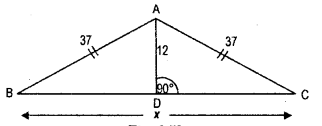
Think, Discuss & Write (Page No. 131):
Question 1.
Which is the longest side in the triangle PQR right angled at P ?
Solution:
Longest side = QR.
Question 2.
Which is the longest side in the triangle ABC right angled at B ?
Solution:
Longest side = AC.

Question 3.
Which is the longest side of a right triangle?
Solution:
Hypotenuse is the longest side of a right triangle.
Question 4.
“The diagonal of a rectangle produce by itself the same area as produced by its length and breadth”-This is Baudhayan theorem and Compare it with the Pythagorean property.
Solution:
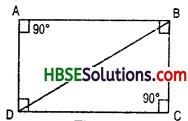
Pythagoras, a Greek philospher of sixth century B.C. is A B said to have found a very important and useful property of right angled triangles. The Indian Mathemetician Baudhayan has also given an equivalent form of this property.
By Pythagoras property, In a right angle triangle,
The square on the hypotenuse = Sum of the squares on the legs.
i.e. h2 = p2 + b2
From above figure,
(BD)2 = (BC)2 + (CD)2
i.e. h2 – p2 + b2
This is Baudhayan Theorem.
![]()

![]()
